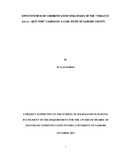| dc.description.abstract | This study sought to find out effectiveness of communication strategies of the “tobacco
kills –quit now” campaign in Nairobi County. The study reviews literature based on the
effectiveness of communication strategies of the “tobacco kills quit now” campaign
which include smoking, Effectiveness of antismoking campaigns, advertising creative
strategies of antismoking campaigns, strategic communication and other interventions for
social change in Kenya. The study employed both qualitative and quantitative methods.
Data collection was undertaken through the following process: Training of research
teams and pre-testing of tools: During this training, pre- testing of tools was undertaken
as part of the research teams’ orientation to the study objectives. 100 questionnaires were
administered and a response rate of 72% was recorded. The collected questionnaires were
sorted, cleaned, and coded. Once coded, the questionnaires were keyed into the Statistical
Package for Social Sciences for analysis. Descriptive statistics was used to analyse the
data and findings were presented in frequency tables, pie charts and bar charts for easy
understanding. Qualitative data from the focus group discussions was summarized using thematic framework and analyzed using NVIVO 10 software. Dominant themes were identified through content analysis where systematic sorting of data was done according to the research objectives. The study established that the anti-smoking campaign by the ministry of health was not grounded on any specific theories of behaviour change. This is despite the fact that grounding a campaign in one or more theories of behaviour change enables campaign planners to explain why and how a campaign should work, thus assessing the campaign’s progress throughout the health communication process. The anti-smoking campaign was however greatly influenced by global best practices and previous researches such as Global Youth Tobacco Survey and Global Adult Tobacco Survey when developing mass media communication strategies. Anti-smoking messaging was only moderately effective in addressing target audience. Target population of the ministry of health was the general household and not specific demographics. In Nairobi, only 40.9% of the smokers quit smoking following anti-smoking messaging on cigarette packets while only 34.9% of the smokers quit smoking following anti-smoking messaging on TV/Radio. The use of English and Swahili only in composing the antismoking message failed to address the population that is only conversant with their vernacular languages. Further, the messaging was appropriate to some extent because the ministry borrowed greatly from global trends and best practices. TV, Radio, Internet and Newspaper are the most accessible channels of communication in Nairobi County. This implies that the tobacco control unit of the ministry of health should not only rely on TV, Radio and Cigarette packet messaging to relay the anti-smoking messages. They should consider other channels of communication like the internet and newspapers. Many people buy cigarettes in single sticks, which imply that they do not manage to read the warnings on the packets. Anti-smoking campaign by the tobacco control unit of the ministry of health was effective in causing behavior change among the target audience only to a moderate extent. This is evidenced by the fact that only 40.9% of the smokers quit smoking following anti-smoking messaging on cigarette packets while only 34.9% of the smokers quit smoking following anti-smoking messaging on TV/Radio. However, majority of the people in Nairobi County are aware of the dangers of smoking and second hand smoking. | en_US |

